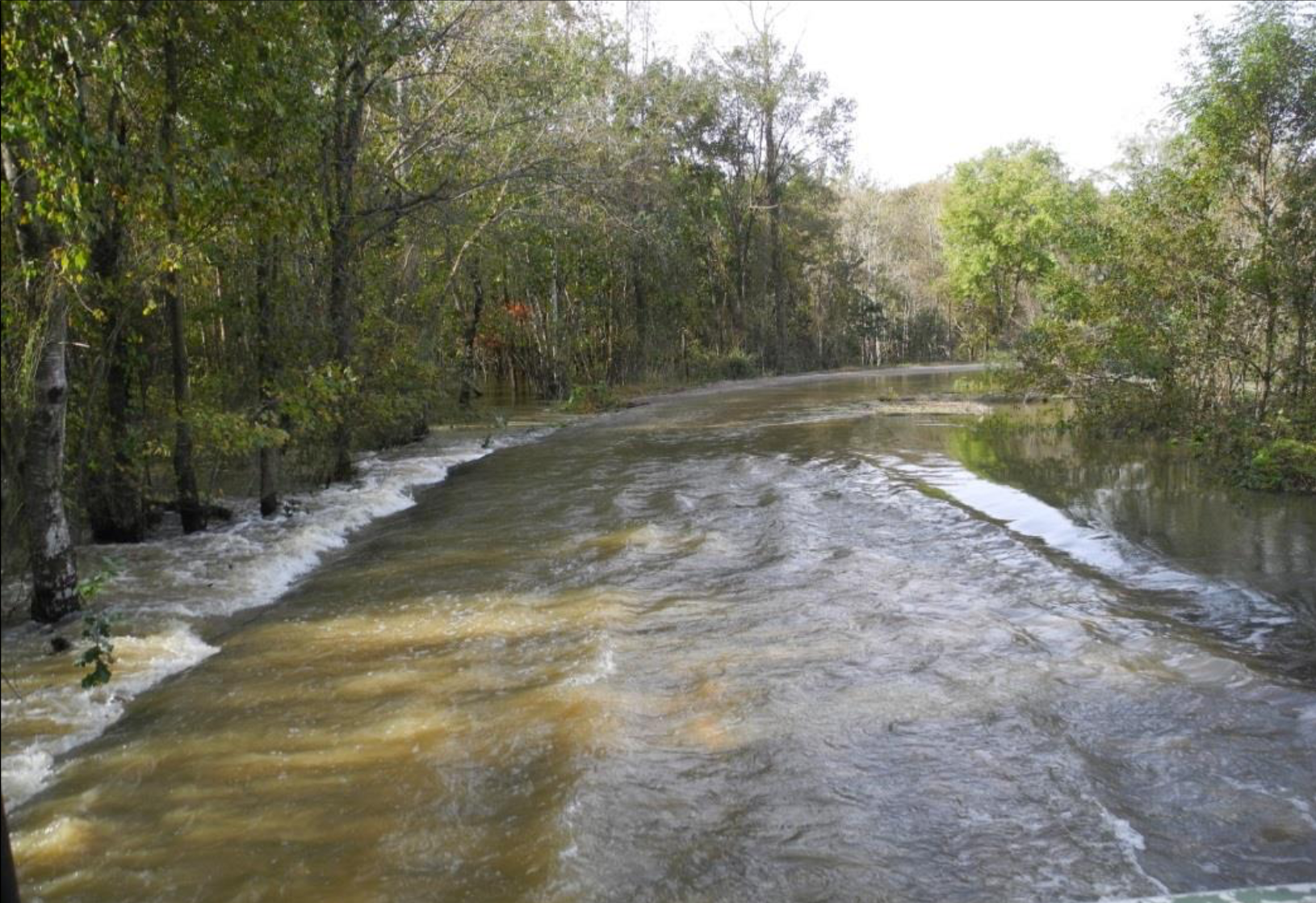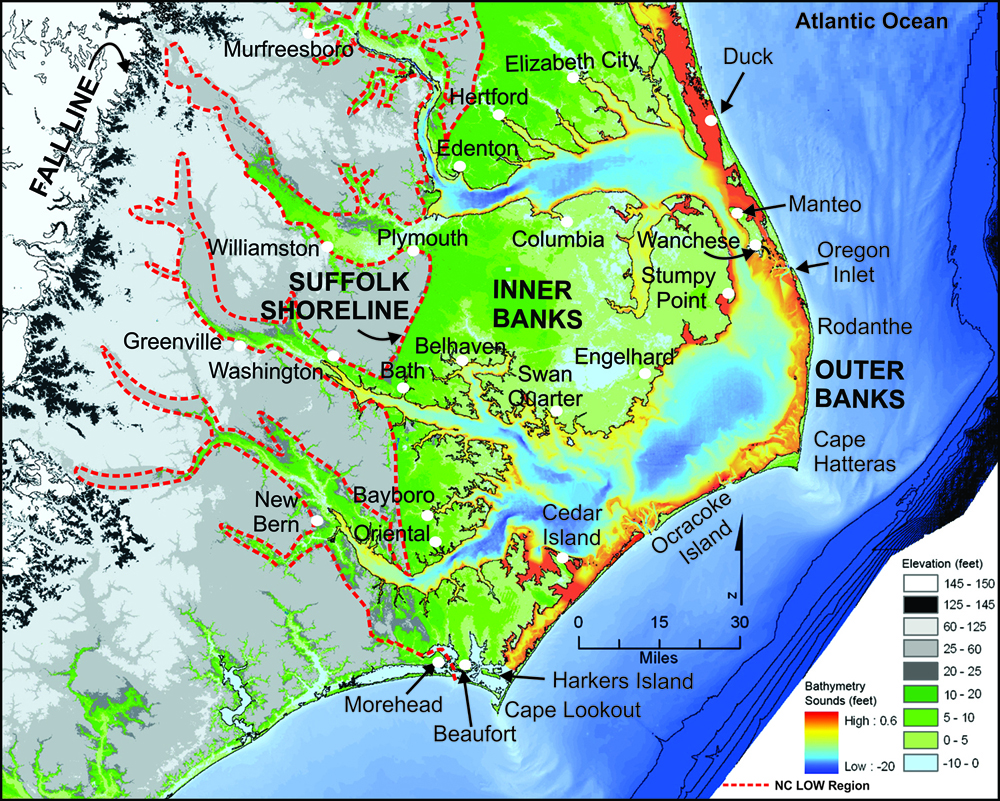The Wiccomoco Bluffs
The Wiccomoco Bluffs of eastern Bertie County are extremely significant components of the entire western Chowan River and Albemarle Sound shorelines. The lower clay bed underlies the entire area and forms the base on which the overlying sand beds occur and supply the sand for the modern sandy beach. All the shells, ironstone, black sand, and white sand that forms the modern beach seaward of the bluff comes from the erosion of the bluff. The white sand is mostly quartz whereas the black sand is made up of various kinds of heavy minerals including magnetite, ilmenite, zircon, rutile, tourmaline, garnets, etc. The surface of the basal clay bed is chock full of fossil marine shrimp and crab burrows. The clay bed is overlain by a shelly clay bed that contains a rich assemblage of fossil marine corals, clams, and oysters.
Flood Dynamics in the Bertie Water Crescent
Small towns in North Carolina’s Land of Water are hard-pressed to create new economic opportunities. Today they face major challenges that include destructive floods, rising sea level, loss of jobs, population declines, high poverty rates, and crumbling infrastructure. In an effort to stimulate new economic opportunities, NC LOW’s strategy is to focus on the natural and cultural, resource-based science, eco-tourism and environmental education as a means of diversifying the rural economy while minimizing the stifling impact of flooding and drought. NC LOW brings this vision to the Bertie County region with the expectation of improving the local quality of life through sustainable economic development that enhances and protects the environment and culture of the region.
Read the full report by clicking here.
Read the abstract here (NC Water Resources Research Institute Conference, March 2020).
THE SCUPPERNONG COASTAL SYSTEM: POCOSINS, CAROLINA BAYS, AND BLACK-WATER STREAMS
AN INTEGRATED, INTERDISCIPLINARY CASE STUDY OF THE NATURAL AND CULTURAL RESOURCES FOR DEVELOPMENT OF ECOTOURISM
“The Scuppernong Story” is an environmental history of a small coastal system through approximately 125,000 years of climate change and landscape evolution. The cultural over-print on these landscapes and their ecosystems represent eleven millennia of human occupation. This story is the natural and cultural history of a dynamic geologic landscape, a complex and highly diverse set of ecosystems, and the human groups who inhabited this region characterized by dramatic environmental evolution.
Read the full report by clicking here.
Economic Mobility in Northeastern NC
“This report presents data on economic mobility, poverty, and educational attainment in the 17-county region; explores recent job loss and projected regional industry growth, noting the wages required to meet basic needs in the region; and makes recommendations for how NC Land of Water can work with regional leaders to increase economic opportunity for Northeastern North Carolinians. MDC approaches this report through the belief that every community wants to be strong and wants to see its people succeed.”
GEOMORPHIC FRAMEWORK OF THE NORTH CAROLINA OUTER BANKS
Including:
CAPE HATTERAS NATIONAL SEASHORE
CAPE LOOKOUT NATIONAL SEASHORE
WRIGHT BROTHERS NATIONAL HISTORIC MONUMENT
FORT RALEIGH NATIONAL HISTORIC SITE AND ROANKE ISLAND
PEA ISLAND NATIONAL WILDLIFE REFUGE
JOCKEY’S RIDGE STATE PARK
Photograph: A 1932 geo-referenced aerial photograph shows the barrier segment from New Inlet on the north to Loggerhead Hills on the south, Pea Island, NC. New Inlet was open numerous times between the 1650s and 1945 when it last closed. Loggerhead Hills is a massive overwash fan that buried the flood-tide delta of Loggerhead Inlet that closed in about 1870. The Loggerhead overwash plain formed prior to the 1917 topographic survey and continued to be active through this 1932 aerial photograph as indicated by the extremely fresh flow characteristics of the tidal channels and associated fan deltas along the western side. This photograph pre-dates major human modification of the barrier islands.
Want to know more about NC LOW?
Friends of NC LOW
A Time for Science
Albemarle-Pamlico National Estuarine Program
Alligator River National Wildlife Refuge
Bertie County
Cape Hatteras National Seashore
Cape Lookout National Seashore
Eastern 4-H Environmental Education Center
East Carolina University
ECU Coastal Studies Institute
Explore North Carolina
Kenan Institute of Engineering, Technology &
Science
Kenan Institute of Private Enterprise
Mattamuskeet National Wildlife Refuge
NC Coastal Atlas
NC Coastal Federation
Friends of NC Low
NC Coastal Land Trust
NC Dept of Commerce—Underserved & Limited
NC Natural Science Museum
NC Partnership for the Sounds
NC Sea Grant Program
NC Space Grant Program
NC Water Resources Research Institute
Pettigrew State Park
Pocosin Arts
Pocosin Lakes National Wildlife Refuge
Reisert Foundation
Roanoke River National Wildlife Refuge
Roanoke River Partners
Somerset Place Historic Site
Town of Windsor
Z. Smith Reynolds Foundation





